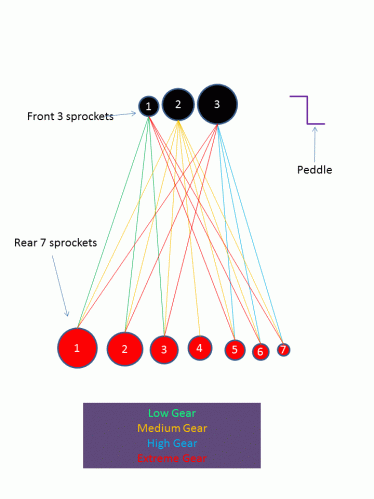Lot of modern bicycles come with gears (derailleur), Mountain bikes also have front and middle suspensions. We will look at the different positions of derailleur gears (21 speed derailleur) and transport restrictions of bicycle as cargo.
As we change the gear from one position to another the derailleur shifts the chain from one sprocket to another, i.e. derailing the chain hence these bicycle gears are called derailleurs. When a rider not used to multispeed (geared) bicycle sit on it for the first time he or she will definitely get confused on the gear positions. More complicated if the bicycle has front and rear derailleurs, then what combination these should be set at. We can see in the image below on the handle bar left hand side there are three positions for the gear shifter and on the right hand 7 positions. (for 21 speed derailleurs)



Always the question asked by a new rider is, 3 x 7 = 21, out of these 21 combinations which one should I use while starting and when should I change the gears while riding? Answer is:
High Gear = Going down hill
Medium Gear = Flat road
Low Gear = Uphill

Every rider is comfortable at his/her own cadence (RPM of the crank/peddling per minute). High gear will put the front derailleur on biggest sprocket and rear on the smaller one. In this position peddling gives more speed but we need to push harder. On low gear the reverse takes place with front derailleur on smallest sprocket, in this position less stress need to be applied on the peddles however speed reduces.
Unless we are cycling uphill or downhill we need not change the gears much. We can leave the front derailleur on position 2 and rear derailleur on position 3 or 4 when starting then keep shifting the rear derailleur from 3 or 4 ( the position of gear we started at) to 2,3,4,5 this will keep our cadence in range and will not increase the stress on legs while maintaining constant speed. There are no many rules for using/shifting these gears, shift the gears as we like to do a comfortable ride keeping our cadence in the same bandwidth. But there are two basic rules which are good for our bicycle more than ourselves.


Rule 1: Never shift the gear when the cycle is in complete stop (resting).
Rule 2: If we are riding on high or low gear before coming to a complete stop shift down to middle gear.
Shifting of gears, front or rear must only be done when peddling to make the shifter push the chain and derail it from the current position to next. If we shift the gear when not peddling there are chances when we push peddle after shifting, the chain may not derail or may fall into a wrong position.
If we stop the bicycle (complete stop) at high or low gear and again start peddling it will apply extra force on the sprockets which may increase wear and tear and eventually we will start hearing it making noise.
To avoid too much strain on the sprockets and chain we should not be changing the gear while applying extra force on peddles like pushing hard on an uphill ride. During hard uphill climb if we want to further drop our gears reduce the force on peddle and shift the gear and continue riding increasing the force.
Although a 21 speed bicycle can go in 21 combinations of speed it is not recommended to use extreme combinations continuously for long duration. Extreme combination will apply extra pressure on sprockets and the angle of chain goes to the extreme positions which may increase possibilities of wear n tear.
Example of extreme combination is Front derailleur position 1 and rear 7 or front derailleur position 3 and rear position 1.
In below image we can see recommended positions (low -medium -high) and extreme position.



Transport Restrictions, Rules
If the shock absorbers (suspensions) are pneumatic or hydraulic then they may be restricted for transport by air.
If you are traveling with your bicycle by air ensure you check with the carrier (airline) well before cycling down to the airport for taking flight. All airlines restrict pressurized articles. Tyres need to be deflated and if your bicycle has pressurized suspensions they may need to be packed, secured etc.
Author is an enthusiastic cyclist who also suffer from chronic neurological disorder called Meralgia paraesthetica. You can contact author for cycling tips and if you also suffer from it then for tips for living with Meralgia paraesthetica 😉


 WhatsApp your queries
WhatsApp your queries